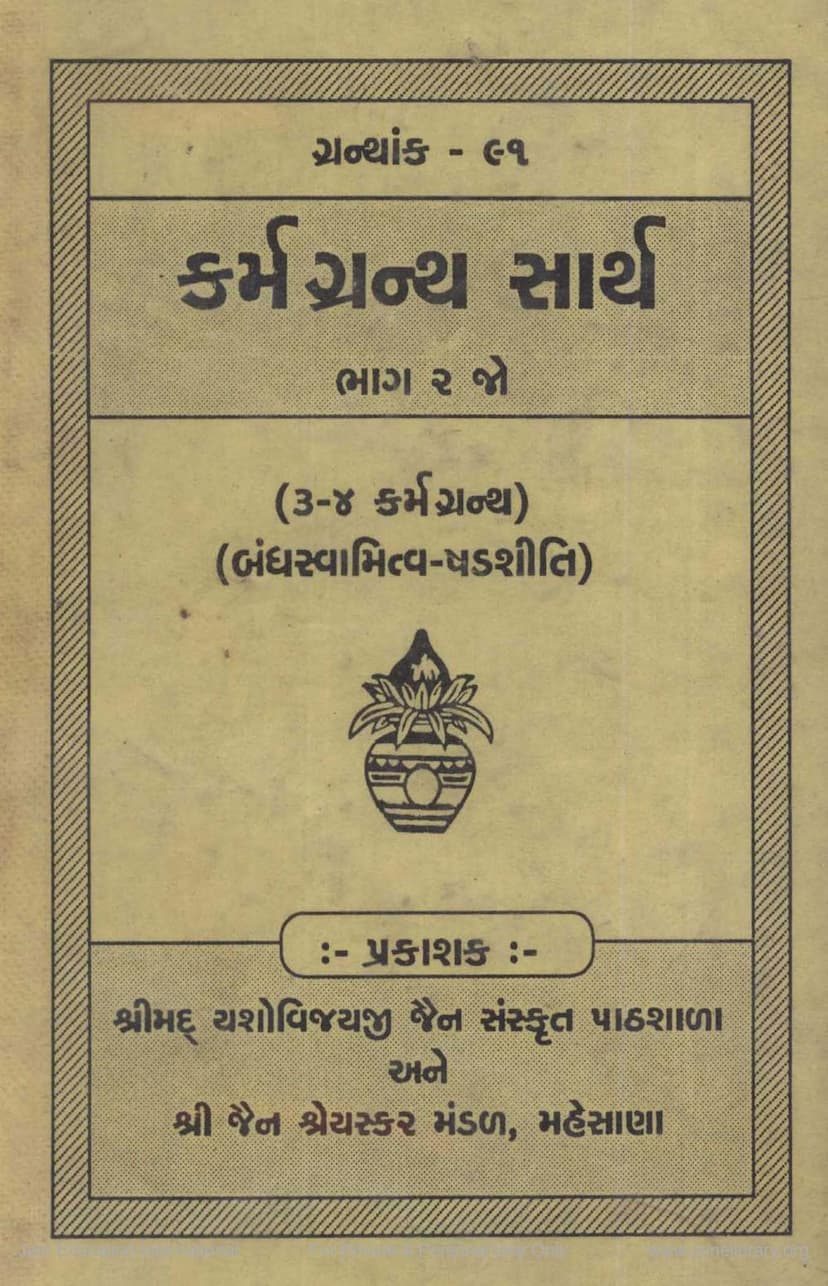Karmagrantha Part 2
Added to library: September 2, 2025

Summary
Here's a comprehensive summary of the Jain text "Karmagrantha Part 2" by Devendrasuri, Jivavijay, and Prabhudas Bechardas Parekh, based on the provided pages:
Book Title: Karmagrantha Part 2 (Also known as Karmagrantha Tris (3) and Chaturth (4) - Bandhasvamitva: Sh Dashiti)
Author(s): Devendrasuri (Original author), Jivavijay (Commentator/Vyakhyakar), Prabhudas Bechardas Parekh (involved in publication/editing)
Publisher: Shrimad Yashovijayji Jain Sanskrit Pathshala and Shri Jain Shreyaskar Mandal, Mehsana
Core Subject Matter:
This part of the Karmagrantha focuses on Bandhasvamitva (The Ownership of Karma Binding) and related concepts within Jain philosophy. It delves into the intricate details of how karma binds to the soul across various states of existence, stages of spiritual development, and types of activities.
Key Concepts and Content Covered:
-
Bandhasvamitva (Ownership of Karma Binding): This is the central theme. The text meticulously explains which soul (in different life forms, states of consciousness, and spiritual paths) binds which karmas. It goes into great detail, often using tabular formats (yantra) and verses, to illustrate the complex interactions between:
- Margana Sthanas (Ways of Classification/Paths of Existence): These are the different ways souls can be classified, such as by:
- Gati (Destiny): Celestial, human, animal, hellish beings.
- Indriya (Senses): One-sensed to five-sensed beings.
- Kaya (Bodies): Earth-bodied, water-bodied, fire-bodied, air-bodied, plant-bodied, and beings with mobile bodies (Trasa).
- Veda (Temperaments): Masculine, feminine, neuter.
- Kashaya (Passions): Anger, pride, deceit, greed.
- Jnana (Knowledge): Different types of valid and invalid knowledge.
- Samyama (Restraint): Stages of ethical conduct.
- Darshana (Perception): Valid and invalid perception.
- Leshya (Disposition/Coloration of the Soul): Black, blue, grey, yellow, red, white.
- Bhava (States of Existence): Such as presence or absence of mind, nourishment, etc.
- Sanjni/Asanjni (Consciousness): With or without consciousness.
- Ahaari/Anaahaari (With or Without Food): Regarding sustenance.
- Gunasthanas (Stages of Spiritual Development): From the lowest (Mithyatva - False belief) to the highest (Sayogi Kevali - Omniscient with a body, and Ayogi Kevali - Omniscient without a body). The text details which karmas bind or do not bind at each of these 14 stages.
- Karma Prakritis: The text refers to a vast number of karma prakritis (actions/karmic effects), categorizing them based on their binding, manifestation (udaya), release (udirna), and permanent existence (satta). It explains which prakritis are bound, experienced, released, or exist in a latent state at different jiva-sthans and gunasthanas.
- Upayoga (Consciousness/Activity): The text analyzes karma binding in relation to the soul's conscious activities.
- Yoga (Activities of Mind, Speech, and Body): It examines karma binding in connection with different types of yogas.
- Alpabahutva (Quantification/Comparison): A significant portion of the text is dedicated to comparing the quantities of karmas or the number of beings in different states, using intricate mathematical concepts like " Sankhyata," "Asankhyata," and "Ananta" with their various permutations. This section is particularly complex and analytical.
- Bhava (States/Modes of Existence): The text discusses the five types of bhavas – Audayika (effect of karma), Paushamika (suppression), Kshayopashamika (partial destruction-suppression), Kshaiika (complete destruction), and Parinamika (natural inherent state). It details which bhavas apply to which souls and karmas.
- Specific Prakritis: The text names numerous karma prakritis, such as Jati Namakarma (types of bodies), Ayu Karma (lifespan), Kashayas, Vedas, etc., and their specific binding conditions.
- Margana Sthanas (Ways of Classification/Paths of Existence): These are the different ways souls can be classified, such as by:
-
Structure and Methodology:
- Vyakhyana (Commentary): The text includes detailed commentary (Vyakhyana) and analysis (Tika) by Muni Jivavijayji, which clarifies the original verses of Devendrasuri.
- Yantra (Diagrams/Tables): The text frequently uses "yantra" (diagrammatic tables) to present complex data on karma binding across marganas and gunasthanas, making the intricate information more accessible.
- Gatas (Verses): The original philosophical content is in the form of verses, which are then explained by the commentator.
- Upayoga (Purpose): The primary purpose seems to be to provide a deep, analytical understanding of karma bondage, emphasizing its pervasiveness and the importance of right conduct to avoid unfavorable bindings. It serves as a guide for spiritual progress by highlighting the consequences of actions at every stage.
Overall Purpose and Significance:
- Detailed Karmic Analysis: This part of the Karmagrantha offers a highly detailed and analytical approach to understanding karma bondage, a fundamental concept in Jainism.
- Interconnection of Concepts: It demonstrates the intricate relationship between different classifications of souls (marganas), spiritual progress (gunasthanas), types of activities (yoga), and karmic manifestation.
- Spiritual Guidance: By elaborating on the binding of various karmas at different stages, the text serves as a guide for practitioners to understand the implications of their actions and strive for liberation by minimizing unfavorable karma.
- Scholarly Work: The inclusion of commentary and the sheer detail of the analysis highlight its significance as a scholarly work within Jain literature, preserving and elaborating upon ancient knowledge.
In essence, "Karmagrantha Part 2" is a profound and exhaustive treatise on the mechanics of karma bondage in Jainism, systematically detailing how and why souls accumulate different types of karma according to their various states and progress on the path to liberation.